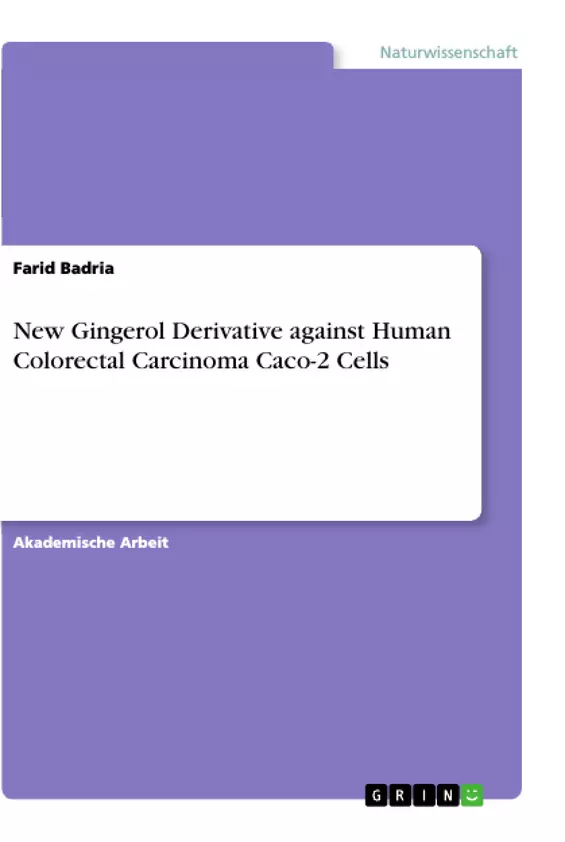In this article we report the isolation, characterization and evaluation of in vitro anti-colon cancer activity of a new gingerol derivative, namely (S,E)-5-hydroxy-1-(4-hydroxy-3- methoxyphenyl)tetradec-8-en-3-one, (N6), and a known sesquiterpene (1,2- Dihydroxybisabola-3,10-diene, N7), isolated from Zingiber officinale rhizomes for the first time, together with other five known compounds. 6-gingerol (N1), 8-gingerol (N2), 10- gingerol (N3), 4-gingerol (N4) and 4`-O-methyl-6-gingerol (N5).
The isolated compounds were identified using different spectroscopic techniques (1D and 2D-NMR, MS and IR). A modified chromatographic method was established and optimized to isolate the major gingerols (N1, N2, and N3) in grams. Thereafter the cytotoxic activity of the isolated compounds was evaluated against colorectal carcinoma cell line, Caco-2. It was observed that anti-colon cancer activity of N2 was superior to that of 5-FU, the classic reference cytotoxic agent. Additionally, the length of the aliphatic chain in 8-gingerol (N2) is optimum for the anticancer activity and any decrease, as in N1 and N4, or increase, as in N3, in the side chain length leads to gradient decrease in the cytotoxic activity.
Following this further, methylation of phenolic OH group (N5), leads to a dramatic decrease in the anticancer activity. Furthermore, loss of aromaticity (N7), results in complete loss of the cytotoxic activity. On the other hand, introducing a π-bond in the aliphatic side chain enhances the anti-cancer activity as depicted in N6. Taken together, the aromaticity, the side chain length as well as the presence of free phenolic group contribute significantly to the anti-colon cancer activity of gingerol and its derivatives. These results open up a new window in the rational design of gingerol-based semisynthetic drugs with improved anticolon cancer activity.
Inhaltsverzeichnis
- Introduction
- Materials and Methods
- Chemicals and reagents
- Plant material
- Extraction and isolation
- Extraction of rhizomes
- Isolation of compounds
- Cell culture
- Cell viability assay
- Statistical analysis
- Results and Discussion
- Isolation and characterization of compounds
- Cytotoxicity activity
- Structure-activity relationship
- Conclusion
Zielsetzung und Themenschwerpunkte
Die vorliegende Studie zielt darauf ab, die in-vitro-Antikrebsaktivität eines neuen Gingerol-Derivats und verwandter Verbindungen aus Zingiber officinale gegen humane kolorektale Karzinomzellen (Caco-2) zu untersuchen. Die Studie strebt an, die Struktur-Aktivitäts-Beziehung zu erforschen, indem sie die Auswirkungen verschiedener Strukturmerkmale auf die Antitumoraktivität analysiert.
- Isolierung und Charakterisierung eines neuen Gingerol-Derivats und anderer verwandter Verbindungen aus Zingiber officinale
- Bewertung der in-vitro-Antikrebsaktivität der isolierten Verbindungen gegen humane kolorektale Karzinomzellen (Caco-2)
- Untersuchung des Einflusses der Strukturmerkmale von Gingerolen auf ihre Antitumoraktivität
- Entwicklung einer optimierten Methode zur Isolierung und Reinigung von Gingerolen
- Potenzielles Design von Gingerol-basierten, semisyntetischen Medikamenten mit verbesserter Antikrebsaktivität
Zusammenfassung der Kapitel
- Introduction: Diese Einleitung beleuchtet die breite Palette an medizinischen Anwendungen von Ingwer, die auf seine antioxidativen, entzündungshemmenden, antimikrobiellen und krebshemmenden Eigenschaften zurückzuführen sind. Die Bedeutung der Gingerole und Shogaole als wichtige pharmakologisch aktive Bestandteile von Ingwer wird hervorgehoben. Die Notwendigkeit, große Mengen an reinen Verbindungen für weitere pharmakologische Studien zu gewinnen, wird betont, wobei die Herausforderungen bei der Trennung durch konventionelle Methoden aufgrund der strukturellen Ähnlichkeit und instabilen chemischen Eigenschaften der Gingerole beleuchtet werden.
- Materials and Methods: Dieser Abschnitt beschreibt die verwendeten Chemikalien und Reagenzien, das Pflanzenmaterial, die Extraktions- und Isolationsverfahren (einschließlich der Extraktion von Rhizomen und der Isolierung von Verbindungen), die Zellkulturmethoden, den Zellüberlebens-Assay und die statistische Analyse.
- Results and Discussion: Dieser Abschnitt präsentiert die Ergebnisse der Isolierung und Charakterisierung der Verbindungen, darunter die Identifizierung eines neuen Gingerol-Derivats und anderer bekannter Verbindungen. Die zytotoxische Aktivität der isolierten Verbindungen gegen humane kolorektale Karzinomzellen (Caco-2) wird detailliert beschrieben. Es wird untersucht, wie die Länge der aliphatischen Kette, die Methylierung der phenolischen OH-Gruppe und der Verlust der Aromatizität die Antitumoraktivität beeinflussen.
Schlüsselwörter
Gingerole, Ingwer, MPLC, Kolorektales Karzinom, Cytotoxizität, Struktur-Aktivitäts-Beziehung, Antitumoraktivität, Caco-2-Zellen, 5-FU, Gingerol-Derivate, Semisynthetische Medikamente.
- Citation du texte
- Farid Badria (Auteur), 2013, New Gingerol Derivative against Human Colorectal Carcinoma Caco-2 Cells, Munich, GRIN Verlag, https://www.grin.com/document/509328



